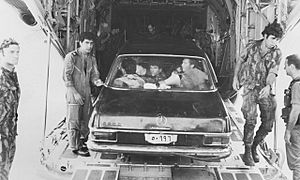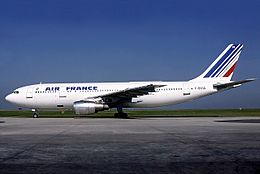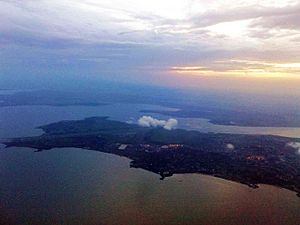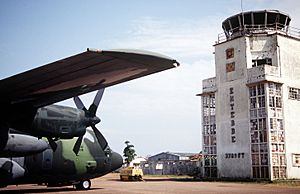Entebbe raid facts for kids
Quick facts for kids Operation Entebbe |
|||||||
|---|---|---|---|---|---|---|---|
| Part of the Arab–Israeli conflict | |||||||
 Israeli commandos from the Sayeret Matkal after the operation. |
|||||||
|
|||||||
| Belligerents | |||||||
Supported by: |
|||||||
| Commanders and leaders | |||||||
| Strength | |||||||
| c. 100 commandos plus air crew and support personnel | 7 hijackers 100+ Ugandan soldiers |
||||||
| Casualties and losses | |||||||
| 1 killed 5 wounded |
Hijackers: 7 killed Uganda: 45 killed 11–30 aircraft destroyed |
||||||
| 3 hostages killed 10 hostages wounded |
|||||||
The Entebbe raid, also known as Operation Thunderbolt or Operation Entebbe, was a daring rescue mission. It was carried out by Israel Defense Forces (IDF) commandos. The mission took place at Entebbe International Airport in Uganda on 4 July 1976. It aimed to free hostages held by terrorists.
A week before, on 27 June, an Air France plane with 248 passengers was hijacked. Two members of the Popular Front for the Liberation of Palestine – External Operations (PFLP-EO) and two Germans from the Revolutionary Cells took control of the plane. They wanted to free 40 Palestinian prisoners in Israel and 13 others in different countries.
The flight was going from Tel Aviv to Paris. After a stop in Athens, it was forced to fly to Benghazi and then to Entebbe, Uganda. The Ugandan government, led by dictator Idi Amin, supported the hijackers. Amin even welcomed them personally.
The hijackers moved all hostages to an old airport building. They separated Israelis and some non-Israeli Jews from the others. Over the next two days, 148 non-Israeli hostages were released. They were flown to Paris. Ninety-four people, mostly Israelis and the 12 Air France crew members, remained. Their lives were in danger.
The IDF used information from Mossad, Israel's intelligence agency. The hijackers threatened to kill the hostages if their demands were not met. This led to the rescue plan. The plan also prepared for fighting Ugandan soldiers.
The rescue happened at night. Israeli transport planes flew 100 commandos over 4,000 kilometers (2,500 miles) to Uganda. The planning took a week, but the actual rescue lasted only 90 minutes. Of the 106 hostages, 102 were saved. Three hostages were killed during the rescue. One hostage, who was in a hospital, was later killed. Five Israeli commandos were hurt, and one, Yonatan Netanyahu, was killed. He was the older brother of Benjamin Netanyahu, who later became Israel's Prime Minister. All seven hijackers and 45 Ugandan soldiers were killed. Eleven Ugandan fighter jets were also destroyed. Kenya helped Israel, and after the operation, Idi Amin ordered the killing of Kenyans in Uganda. As a result, 245 Kenyans were killed, and 3,000 fled.
Contents
The Hijacking Story

|
|
| Hijacking summary | |
|---|---|
| Date | 27 June 1976 |
| Summary | Hijacking |
| Place | Greek airspace |
| Passengers | 248 |
| Crew | 12 |
| Injuries (non-fatal) | 10 |
| Fatalities | 4 |
| Survivors | 256 |
| Aircraft type | Airbus A300B4-203 |
| Airline/user | Air France |
| Registration | F-BVGG |
| Flew from | Ben Gurion Int'l Airport, Israel |
| Stopover | Athens (Ellinikon) Int'l Airport, Greece |
| Flying to | Charles De Gaulle Int'l Airport, France |
On 27 June 1976, Air France Flight 139 took off from Tel Aviv, Israel. It carried 246 passengers, mostly Jewish and Israeli, and 12 crew members. The plane stopped in Athens, Greece, where 58 more passengers boarded, including four hijackers. The flight left Athens for Paris at 12:30 pm.
Soon after takeoff, the plane was hijacked. Two Palestinians from the PFLP-EO and two Germans, Wilfried Böse and Brigitte Kuhlmann, took control. They forced the plane to fly to Benghazi, Libya. The plane stayed there for seven hours to refuel. During this time, the hijackers released one British-Israeli passenger who pretended to be sick. The plane then left Benghazi. At 3:15 pm on 28 June, it arrived at Entebbe International Airport in Uganda.
Hostages in Danger
At Entebbe, at least four more hijackers joined the original group. They were supported by soldiers from Uganda's president, Idi Amin. The hijackers moved the passengers to the transit hall of an old airport terminal. They kept them guarded there for several days. Idi Amin visited the hostages almost daily. He told them about the situation and promised to help free them through talks.
On 28 June, a hijacker announced their demands. They wanted US$5 million for the plane's release. They also demanded the release of 53 Palestinian and pro-Palestinian fighters. Forty of these fighters were prisoners in Israel. The hijackers threatened to start killing hostages on 1 July 1976 if their demands were not met.
Separating the Hostages
On 29 June, Ugandan soldiers broke down a wall to a room next to the crowded waiting hall. The hijackers then separated the Israelis from the other hostages. They told the Israelis, including those with dual citizenship, to move to the new room. One Holocaust survivor showed hijacker Wilfried Böse a camp registration number tattooed on his arm. Böse said, "I'm no Nazi! I am an idealist."
Five non-Israeli hostages were also forced to join the Israeli group. These included two Jewish couples from the US and Belgium, and a French resident of Israel. The captors suspected them of hiding their Israeli identities. However, at least one Israeli military officer with dual citizenship was not identified. He was later freed with other non-Israeli hostages. Some non-Israeli hostages, like Janet Almog and Jocelyne Monier, chose to join the Israeli group.
Releasing Some Hostages
On 30 June, the hijackers released 48 hostages. These were mainly elderly, sick passengers, and mothers with children from the non-Israeli group. Forty-seven of them flew by a chartered Air France plane to Paris. One passenger was treated in a hospital for a day.
On 1 July, the Israeli government agreed to negotiate. The hijackers then extended their deadline to noon on 4 July. They released another 100 non-Israeli captives. These hostages were also flown to Paris a few hours later. The remaining 106 hostages included the 12 Air France crew members, who refused to leave, about ten young French passengers, and around 84 Israelis.
Planning the Rescue Mission
In the week before the raid, Israel tried to free the hostages through talks. The Israeli government was ready to release Palestinian prisoners if a military rescue seemed impossible. A retired Israeli officer, Baruch Bar-Lev, knew Idi Amin well. He spoke with Amin many times, trying to get the hostages released, but it didn't work.
Israel also asked the United States to tell Egyptian president Anwar Sadat to ask Amin to release the hostages. Prime Minister Yitzhak Rabin and Defense Minister Shimon Peres disagreed for a week. Rabin wanted to give in to the hijackers' demands. Peres wanted to prevent more terrorism by not giving in.
When the 1 July deadline arrived, Israel offered to talk to the hijackers. They asked to extend the deadline to 4 July. Amin also asked for this extension. This allowed him to attend a meeting in Mauritius. This extra time was very important for Israeli forces to prepare for the rescue.
On 3 July, at 6:30 pm, the Israeli government approved a rescue mission. It was presented by Major General Yekutiel Adam and Brigadier General Dan Shomron. Shomron was put in charge of the operation.
Getting Ready for the Mission
When talks failed, Israel decided a military rescue was the only way. The lead pilot, Lt. Col. Joshua Shani, said they first thought of dropping naval commandos into Lake Victoria. These commandos would use rubber boats to reach the airport. They would kill the hijackers and free the hostages. Then they would ask Amin for safe passage home. This plan was dropped because there wasn't enough time. Also, they heard Nile crocodiles lived in Lake Victoria.
Amnon Biran, the mission's intelligence officer, said they didn't know the airport's exact layout. They also didn't know the hostages' exact location or if the building had explosives.
Aircraft Refueling
The Israeli forces needed to refuel their Lockheed C-130 Hercules planes on the way to Entebbe. Israel couldn't refuel four to six planes in the air so far from home. Several East African countries were helpful, especially Kenya. But none wanted to anger Amin or the Palestinians by letting Israel land planes.
The rescue needed help from at least one East African government. Israel got permission from Kenya to fly through its airspace. They could also refuel at Jomo Kenyatta International Airport in Nairobi. Kenya's Agriculture Minister, Bruce MacKenzie, convinced President Jomo Kenyatta to help. MacKenzie allowed Mossad to gather information before the mission. He also let the Israeli Air Force use Nairobi airport.
Uganda's Ambassador to Lesotho, Isaac Lumago, heard about the plan. He told Ugandan commander Isaac Maliyamungu. But Maliyamungu didn't tell Amin or act on the information. He thought it was "rubbish." However, Amin's son said his father did get Lumago's warning by phone. Amin flew back to Uganda after his meeting. An ex-agent of Uganda's intelligence service also said Amin knew about the raid. This agent claimed Amin was afraid of fighting the Israeli military. So, he ordered the Uganda Army not to shoot at Israeli planes.
Hostage Information
Mossad gathered good information about the hostages. They knew how many hijackers there were and about Ugandan soldiers' involvement. This information came from the hostages who had been released in Paris. Israeli companies had also built things in Africa in the 1960s and 70s. The Israeli army talked to Solel Boneh, a big Israeli construction company. This company had built the terminal where the hostages were held. For the mission, the IDF built a partial copy of the airport terminal. Civilians who helped build the original airport assisted them.
IDF major Muki Betser said Mossad agents talked a lot to the released hostages. He said a French-Jewish passenger with military experience had a "phenomenal memory." This person gave detailed information about the hijackers' weapons.
The Rescue Team
The Israeli ground team had about 100 people. It included:
- Ground Command: This small group had the overall commander, Brigadier General Dan Shomron. It also had an air force representative and communication staff.
- Assault Team: A 29-man unit led by Lt. Col. Yonatan Netanyahu. These were Sayeret Matkal commandos. Their main job was to storm the old terminal and save the hostages. Major Betser led one of the assault teams and took command after Lt. Col. Netanyahu was killed.
- Security Teams:
- The Paratroopers led by Col. Matan Vilnai. They secured the airport, cleared runways, and protected Israeli planes.
- The Golani force led by Col. Uri Sagi. They secured the C-130 Hercules plane for the hostages' escape. They also acted as backup.
- Another Sayeret Matkal force led by Major Shaul Mofaz. They cleared the military airstrip and destroyed Ugandan fighter jets. This stopped any possible attacks from the Uganda Army Air Force. They also held off enemy forces from Entebbe city.
The Daring Raid

The Flight Path
The rescue team took off from Sharm el-Sheikh. They flew over the Red Sea, mostly at a low height of 30 meters (100 feet). This helped them avoid being seen by radar from Egypt, Sudan, and Saudi Arabia. Near the southern end of the Red Sea, the C-130s turned south. They flew into Ethiopian territory, west of Djibouti. From there, they went northeast of Nairobi, Kenya. They then turned west, flying over the African Rift Valley and Lake Victoria.
Two Boeing 707 jets followed the cargo planes. The first Boeing had medical equipment and landed in Nairobi, Kenya. The operation commander, General Yekutiel Adam, was on the second Boeing. This plane circled over Entebbe Airport during the raid.
The Surprise Attack
The Israeli forces landed at Entebbe on 3 July at 11:00 pm Israel time. Their cargo bay doors were already open. Because the airport layout wasn't fully known, the first plane almost drove into a ditch. The Israelis brought a black Mercedes car that looked like President Idi Amin's vehicle. They also had Land Rovers that usually went with Amin's car. They hoped to use these to get past security.
As they neared the terminal, two Ugandan guards saw them. They knew Idi Amin had recently bought a white Mercedes. The guards ordered the vehicles to stop. The first commandos shot the guards with silenced pistols. This was not part of the plan, as they were supposed to ignore the guards. An Israeli commando in a Land Rover behind them then fired an unsuppressed rifle. Fearing the hijackers would be warned too early, the assault team quickly moved towards the terminal.

The Israelis left their vehicles and ran to the terminal. The hostages were in the main hall, right next to the runway. As they entered, the commandos shouted, "Stay down! We are Israeli soldiers!" in both Hebrew and English. Jean-Jacques Maimoni, a 19-year-old French immigrant to Israel, stood up. He was killed when Muki Betser and another soldier thought he was a hijacker. Another hostage, Pasco Cohen, 52, was also badly wounded by gunfire. A third hostage, Ida Borochovitch, 56, was killed by a hijacker in the crossfire.
According to hostage Ilan Hartuv, Wilfried Böse was the only hijacker who entered the hostage hall after the attack began. He first pointed his Kalashnikov rifle at hostages. But then he "immediately came to his senses" and told them to hide in the restroom. He was then killed by the commandos. Hartuv said Böse only fired at Israeli soldiers, not at hostages.
At one point, an Israeli commando asked in Hebrew, "Where are the rest of them?" meaning the hijackers. The hostages pointed to a door connecting to the main hall. The commandos threw several hand grenades into the room. They then entered and shot the three remaining hijackers, ending the main attack.
Meanwhile, the other three C-130 Hercules planes had landed. They unloaded armoured personnel carriers for defense during refueling. The Israelis then destroyed Ugandan MiG fighter planes on the ground. This stopped them from chasing the Israeli planes. They also searched the airfield for information.
Leaving Entebbe
After the raid, the Israeli team went back to their planes and started loading the hostages. Ugandan soldiers shot at them. The Israeli commandos fired back, hitting the Ugandans. During this short but intense fight, Ugandan soldiers fired from the airport control tower. At least five commandos were wounded. The Israeli unit commander, Yonatan Netanyahu, was killed. Israeli commandos fired machine guns and a rocket-propelled grenade at the control tower. This stopped the Ugandans' fire.
According to one of Idi Amin's sons, the soldier who shot Netanyahu was killed in the return fire. The Israelis finished getting the hostages on board. They loaded Netanyahu's body into one of the planes and left the airport. The whole operation lasted 53 minutes. The actual attack lasted only 30 minutes. All seven hijackers and between 33 and 45 Ugandan soldiers were killed. Eleven Soviet-built MiG-17 and MiG-21 fighter planes were destroyed. Out of 106 hostages, three were killed. One, 74-year-old Dora Bloch, was left in Uganda and later killed. About 10 hostages were wounded. The 102 rescued hostages flew to Israel through Nairobi, Kenya, soon after the raid.
After the Rescue
Idi Amin was very angry about the raid. He reportedly said he could have taught the Israelis a lesson if he had known they were coming. After the raid, Ugandan commander Maliyamungu arrested 14 soldiers. He suspected them of helping the Israelis. He then shot 12 of them with his pistol.
Dora Bloch, a 74-year-old Israeli-British citizen, was taken to a hospital in Kampala. She had choked on a chicken bone. After the raid, she was killed by Ugandan army officers. Some of her doctors and nurses were also killed for trying to help her. In 1987, Henry Kyemba, Uganda's Justice Minister at the time, said Bloch was dragged from her hospital bed and killed on Amin's orders. Her body was found in 1979, after Amin's rule ended.
Amin also ordered the killing of hundreds of Kenyans in Uganda. This was revenge for Kenya helping Israel. Uganda killed 245 Kenyans, including airport staff. About 3,000 Kenyans fled Uganda to avoid being killed.
On May 24, 1978, Kenya's agriculture minister, Bruce MacKenzie, was killed. A bomb on his plane exploded after he met with Amin. Some believe Amin ordered this to get revenge for MacKenzie's help in the raid. Others think someone else on the plane was the target. Later, Mossad Director Meir Amit had a forest planted in Israel in MacKenzie's name.
International Reactions
The United Nations Security Council met on 9 July 1976. They discussed a complaint from the Organization of African Unity. It said Israel had committed an "act of aggression." The UN Secretary General Kurt Waldheim said the raid was "a serious violation of the sovereignty of a Member State." But he also said it was about "international terrorism." Uganda's representative said a peaceful solution was close when Israel attacked. Israel's ambassador, Chaim Herzog, accused Uganda of helping the hijackers.
The US and UK proposed a resolution. It condemned hijacking and similar acts. It also regretted the loss of life but did not blame Israel or Uganda. It called for respecting countries' sovereignty and improving air safety. This resolution did not pass. Another resolution, which condemned Israel, was not voted on.
Western countries supported the raid. West Germany called it "an act of self-defence." Switzerland and France praised the operation. The United Kingdom and United States praised the Entebbe raid as "an impossible operation." Some in the United States noted the hostages were freed on 4 July 1976. This was 200 years after the signing of the United States Declaration of Independence.
The hijacked plane's pilot, Captain Michel Bacos, received the Legion of Honour. Other crew members received the French Order of Merit.
In 1980, The Norfolk hotel in Nairobi was bombed. It was owned by a Jewish community member. The bomb killed 20 people and injured 87. It was believed to be revenge by pro-Palestinian groups for Kenya's help in Operation Entebbe.
Over the years, Major Betser and the Netanyahu brothers, Iddo and Benjamin, argued publicly. They debated who was to blame for the early firefight that killed Yonatan and partly ruined the surprise.
Because of this operation, the United States military created rescue teams. These teams were based on the Israeli unit used in Entebbe. One famous attempt was Operation Eagle Claw in 1980. This mission failed to rescue American embassy staff held hostage in Tehran.
The hijacked plane, Air France Flight 139 (F-BVGG), was repaired and returned to service. It was later used by other airlines and eventually scrapped in 2020.
Remembering the Raid
In August 2012, Uganda and Israel held a ceremony to remember the raid. It took place at the old Entebbe Airport, where Yonatan Netanyahu was killed. Uganda and Israel promised to "fight terrorism." Wreaths were laid, and speeches were given. The flags of Uganda and Israel flew together, showing their good relationship. A plaque tells the story of the raid. Ugandan State Minister for Animal Industry Bright Rwamirama and Israel's Deputy Foreign Affairs Minister Daniel Ayalon attended. Forty years after the rescue, Israeli Prime Minister Benjamin Netanyahu, Yonatan's brother, visited Entebbe. He worked to improve relations between Israel and African countries.
Films and Documentaries
Many films and documentaries have been made about Operation Entebbe:
Documentaries
- Operation Thunderbolt: Entebbe is a documentary about the hijacking and rescue.
- Rise and Fall of Idi Amin (1980) briefly shows the raid.
- Rescue at Entebbe (2005) is an episode of the series Against All Odds: Israel Survives.
- Cohen on the Bridge (2010) features interviews with surviving commandos and hostages.
- Live or Die in Entebbe (2012) follows Yonatan Khayat's search for details about his uncle's death.
- "Assault on Entebbe" is an episode of the National Geographic Channel show Critical Situation.
- Operation Thunderbolt (2012) is an episode of the Black Ops series.
Dramatisations
- Victory at Entebbe (1976) stars Anthony Hopkins and Elizabeth Taylor.
- Raid on Entebbe (1977) features Peter Finch and Charles Bronson.
- Operation Thunderbolt (1977) stars Yehoram Gaon as Col. Netanyahu.
- The Last King of Scotland (2006) includes the raid as part of Idi Amin's story.
- Entebbe (2018) is a more recent film about the event.
Films Inspired by the Operation
- The Delta Force (1986) features a similar hostage rescue.
- Zameen (2003) is a Bollywood movie with a rescue plan based on Operation Entebbe.
Other Media
- Operation Thunderbolt (1988) is an arcade game loosely based on the event.
- To Pay the Price (2009) is a play partly based on Yonatan Netanyahu's letters.
Images for kids
See also
 In Spanish: Operación Entebbe para niños
In Spanish: Operación Entebbe para niños
- Air France Flight 8969 – a similar hijacking and raid on another Air France airliner in 1994
- Aspen Movie Map – a project whose funding came about because of Operation Entebbe
- Israeli casualties of war
- List of hostage crises
- Lufthansa Flight 181 – a similar event the following year, involving a German airliner
- Military Intelligence Directorate (Israel) (Aman) – Israel's military intelligence agency
- Operation Mikado – a proposed SAS operation during the Falklands War inspired by Operation Entebbe
- Operation Niki – a clandestine airlift of a battalion of Greek commandos from Crete to Cyprus in 1974
- Sayeret – Israeli Special Forces Units








